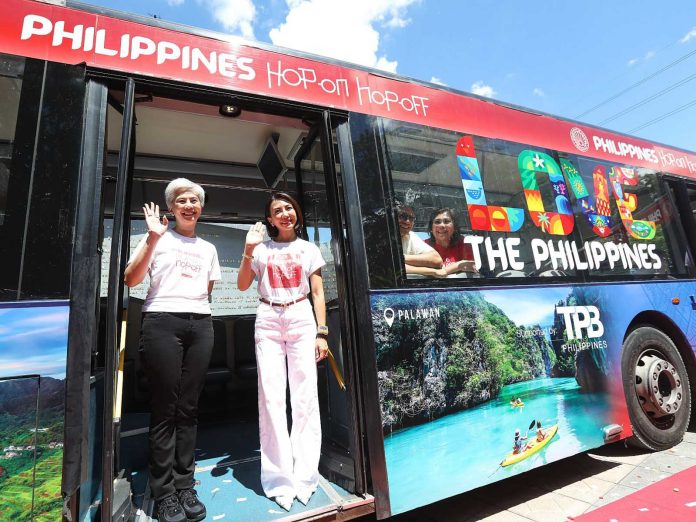Only Tourism Secretary Christina Frasco knows if it’s faith or face-saving. But her retention of “Love the Philippines” as a slogan, despite the international scandal its video brought, presents three complications.
First, effectiveness. Will the slogan still entice foreign tourists? Second, disrepute. Can Philippine tourism afford a fourth complaint of plagiarized promos? Third, legal-financial. How can the Department of Tourism terminate, without pay, the ad agency that created the slogan and controversial video?
The tourism forum that Frasco graced Wednesday, July 5, featured the “Love the Philippines” logo onscreen. Asked if she’ll keep the slogan, she pointed to the stage saying, “It’s evident.”
The video that launched “Love the Philippines” intended to promote local attractions but used foreign stock footage: Indonesian rice terraces, a Thai fisherman, Dubai sand dunes, Brazilian beaches, and a Lufthansa jet landing in Zurich.
It keynoted DOT’s 50th-anniversary fete last June 27. By the weekend world media reported the inappropriate scenes. Netizens and travelogues scoffed at it.
Perplexed, for one, was Indonesia’s tourism minister on viewing the 105-second video. The Philippine affiliate of the multinational ad agency Doyle, Dane & Bernbach apologized Sunday, July 2. The next day DOT announced DDB’s termination and forfeiture of the performance bond.
Before the fiasco DDB’s slogan “enjoyed a positive sentiment of 77% on social media,” PRWeek quoted media analyst Charles Cheung of Carma. “As a result of the incident, the brand sentiment has become 34.7% negative and only 3.7% positive.” PRWeek is a global journal of the public relations industry; Carma is a top media intelligence provider.
Insisting on the slogan makes it doubly difficult for Frasco to sell the Philippines. Despite Filipinos’ vaunted hospitality and the country’s attractions, infrastructures and accessibility pale in comparison to Southeast Asian neighbors. A tainted trademark will further pull down the Philippines’ tourism standing.
Besides, DOT seems confused about its target audience. “Love the Philippines” supposedly is to promote the country abroad. Thus, the shortlisting of DDB and one other global agency in the consultancy contract bidding. But Frasco also directed the slogan to local tourists.
She enthused: “‘Love the Philippines’ is not a mere branding campaign, but a call to action to every Filipino citizen to remember the beauty of our country, to honor our past, and to look forward to the future armed with the virtues, (and) values of being a Filipino.”
But “Love the Philippines” is criticized as a copy of two recent promos, “Love Cyprus” and “Love Barbados”. PRWeek recounted three other “plagiarized” Philippine brands.
The logo of “Pilipinas Kay Ganda”, 2010, allegedly aped that of Poland’s. “It’s More Fun in the Philippines”, 2012, rehashed the 1951 “It’s more fun in Switzerland”. “Experience the Philippines”, 2017, mimicked aspects of the 2016 “Meet South Africa” featuring blind travelers.
Incidentally, a former Dinagat Island provincial information officer tweeted Tuesday about the unattributed use of her photo in a localized version of “Love the Philippines”. The Dinagat Island’s tourism office quickly apologized and took down the sunset picture at San Jose town.
In 2012-2019 DOT attracted 33.4 million travelers with “It’s More Fun”, a compounded annual growth rate of 8.6 percent. “Wow Philippines”, 2002-2010, drew in 20.84 million, 5.8 percent.
Experts attribute the slight increases not so much to the slogans than the slow upgrade of facilities and transport. Bad airports and sanitation, and too few rides, rest stops, and emergency clinics continue to turn off tourists.
Frasco has yet to clarify money matters. DDB and DOT claim that no public money was spent for the awkward video. But she said June 27 that the “Love the Philippines” rebranding cost P49 million.
Three components comprise the campaign, DOT’s website shows: branding, P50 million; production of five video ads, P250 million; overseas media placements, P250 million.
DDB’s canceled contract and forfeited performance security, was apparently what Frasco valued at P49 million. As of June 9, it was shortlisted for the two bigger deals.
In apologizing, DDB said it produced on its own “a mood video to excite internal stakeholders.” Impliedly, not for public viewing. Whoever authorized its unveiling last June 27 and posting on DOT’s website has remained unidentified. The ad agency can contest its abrupt firing without remuneration and what DOT calls “any other engagement.”
Jarius Bondoc is an award-winning Filipino journalist and author based in Manila. He writes opinion pieces for The Philippine Star and Pilipino Star Ngayon and hosts a radio program on DWIZ 882 every Saturday. Catch Sapol radio show, Saturdays, 8 to 10 a.m., DWIZ (882-AM).









